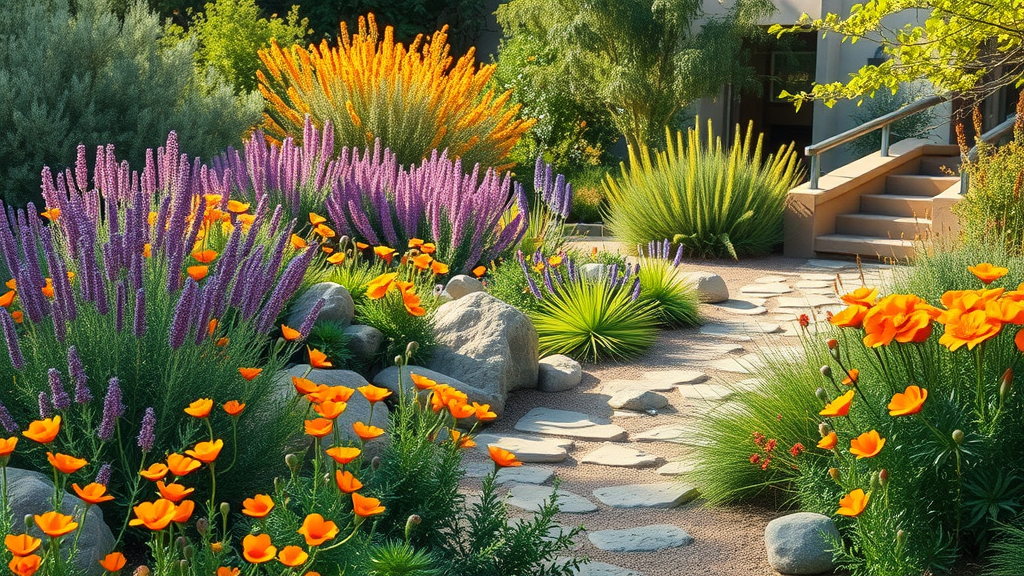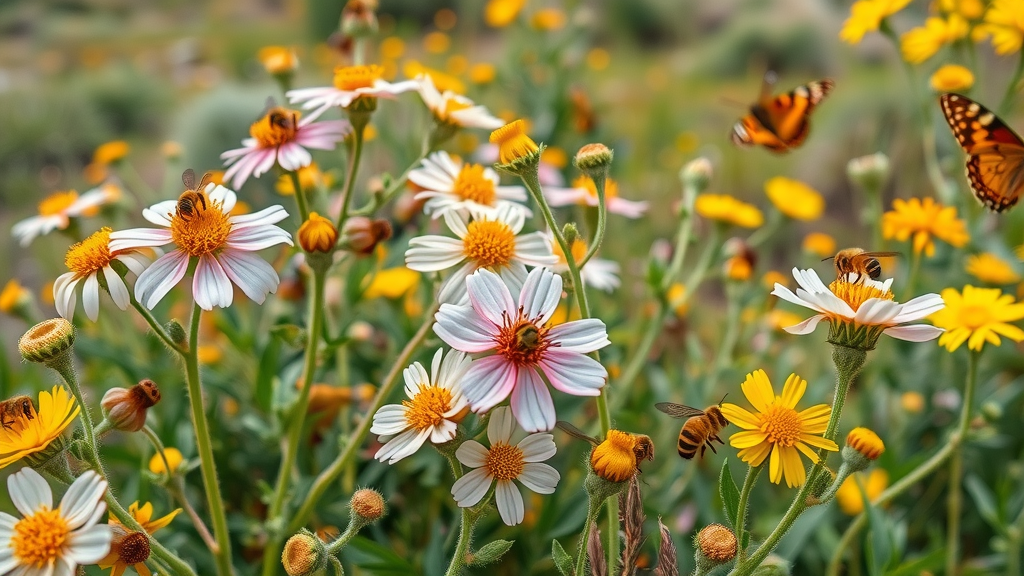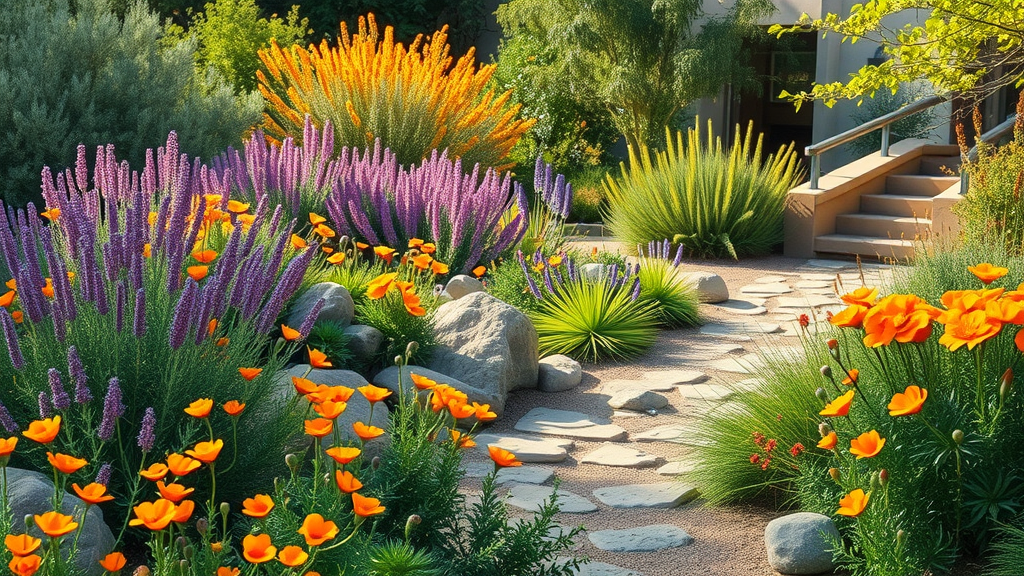
Landscape Design for Dry Seasons: Beat Drought Effects Now
November 4, 2025
Irrigation Systems for Dry Climates: Water Smart Solutions
November 18, 2025Did you know that over 70% of residential water use in Southern California goes to landscaping? Embracingnative plants Southern Californiacan cut this figure in half while providing a stunning, sustainable garden. This article reveals how you can harness the beauty and resilience of California native plants, making your San Diego garden both low-maintenance and eco-friendly. Whether you’re looking to reduce water bills, support local wildlife, or create a landscape that thrives during Southern California’s dry winters, you’ll find everything you need to get started here.

Native Plants Southern California: Surprising Facts for San Diego Gardens
“Did you know that over 70% of residential water use in Southern California goes to landscaping? Embracing native plants Southern California can cut this figure in half while providing a stunning, sustainable garden.”
When it comes to water conservation and sustainable landscaping in San Diego, native plants Southern California stand out as an invaluable solution. Not only are these plants beautiful, but their adaptation to the local climate makes them remarkably easy to care for, especially during the region’s dry winters. By simply transitioning to California native plants, homeowners can enjoy time-saving maintenance routines, support essential pollinators, and help preserve the unique biodiversity of the California Floristic Province. The collaborative efforts of water agencies and the California Native Plant Society reinforce these practices, highlighting not just ecological benefits but practical savings on water usage and garden upkeep.
It’s not just about conserving resources – native plant species like ceanothus, manzanita, and California poppy also provide vital habitats for local wildlife and insects, making your garden a true hub of natural activity. These wild plants thrive with less irrigation, resist invasive species naturally, and showcase stunning blooms that easily rival any exotic landscaping species. If you want a landscape that works with nature, not against it, choosing native plants southern California is the ultimate path toward year-round color, resilience, and low-maintenance charm.
What You’ll Learn About Native Plants Southern California
- Why native plants southern California are key to sustainable landscaping
- How to select, plant, and care for California native plants
- Low-maintenance plant choices for dry San Diego winters
- The role of the California Native Plant Society and water agencies
- Potential challenges: invasive species and water needs
Understanding Native Plants Southern California and Their Benefits
What Makes Native Plants Ideal for Southern California Gardens

- Drought tolerance
- Adaptation to local soils and climate
- Support for wildlife and pollinators
- Water savings – endorsed by regional water agencies
“California native plants have evolved over thousands of years to thrive in our unique climate, making them both resilient and resource-efficient.” — California Native Plant Society
Native plants Southern California are especially prized for their ability to endure the region’s dry and variable climate. Over centuries, these native species have developed resilient root systems, efficient water uptake, and high compatibility with local soil conditions. Unlike many imported ornamentals, these plant species flourish without chemical fertilizers or excessive irrigation, making them the gold standard for sustainability according to both the California Native Plant Society and local water agencies. Their profound adaptation reduces water bills and prevents erosion, offering a natural balance to gardens shaped by dry San Diego winters.
Beyond their practical advantage, native flora is critical in supporting South California’s unique biodiversity. Indigenous plants like ceanothus, manzanita, and toyon supply food and habitat for local birds, bees, and butterflies — turning your home garden into a vital piece of the natural habitat. By letting these wild plants take center stage, you aid pollination processes and reduce the risks of harmful invasive species, all while keeping your landscape visually captivating year-round. As a result, native plants Southern California not only bring beauty and ease to your garden but also contribute to the larger environmental health of the region.
| Plant Name | Type | Water Needs | Sun Requirement | Wildlife Benefit |
|---|---|---|---|---|
| Ceanothus | Shrub | Low | Full Sun | Bees, Butterflies |
| California Poppy | Annual | Low | Full Sun | Pollinators |
| Toyon | Shrub | Low | Part Shade | Birds |
| Manzanita | Shrub | Low | Full Sun | Mammals, Birds |
How to Prepare and Plant Your Landscape with Native Plants Southern California
Site Assessment and Soil Preparation for California Native Plant Gardens

Preparing your garden for native plants southern California begins with a thorough assessment of your landscape. First, observe your yard’s sun patterns, existing vegetation, drainage, and microclimates. Many native plant species thrive in rocky, sandy, or even clay soils, but amending compact or artificial soils can give your plants a head start. Using a simple soil test kit, check for pH and nutrient levels—often, you’ll find native flora are more tolerant than ornamentals, needing fewer amendments and less fertilizer. Strategic planning, such as following recommendations from your local water agency and referencing demonstration gardens, allows you to match plant communities to your unique site for maximum results.
When it comes to soil prep, less is often more. Loosen compacted areas and enrich only with natural compost if needed. Many California native plants prefer well-drained soils—if your yard is heavy clay, consider raised beds or berms. Remember, a healthy native habitat is built upon proper plant spacing, mulching with natural wood chips, and minimal disturbance to the existing soil structure. By heeding this process, your native plant garden is set up for years of sustainable, low-maintenance growth in your San Diego landscape.
Plant Selection: Top California Native Plants & Local Nursery Sources
- Ceanothus
- Manzanita
- Toyon
- California poppies
- Sages
- Local water agency plant lists
Choosing the right native plant varieties is a crucial step to garden success in Southern California. Local favorites like ceanothus and manzanita are celebrated not just for their stunning seasonal blooms, but also for their longevity and resilience. California poppies create vibrant groundcover, while sages infuse the air with fresh scents and provide nectar to hummingbirds. Consult the California Native Plant Society or your regional water agency for up-to-date lists of recommended species, or visit retail nurseries like the Theodore Payne Foundation, known for their wide selection of native flora and practical advice. These resources emphasize plants perfectly calibrated for San Diego’s climate, ensuring your efforts result in beautiful, thriving gardens with minimal maintenance.
It’s also wise to tour demonstration gardens and botanical centers in your area, where you can see firsthand how specific California native plants perform in various microclimates. Working with local experts or a native plant specialist will further streamline the selection and installation process, making your landscape transition efficient and rewarding. By focusing on these carefully selected native plants southern California, you’re investing in a landscape that is water-wise, wildlife-friendly, and built to last.
Installation Tips for Southern California Gardens
Proper installation is essential to helping your native plant picks survive that critical first year. Start by planting during the cooler, wetter months — ideally late fall through early spring. Dig holes twice as wide as the plant’s container but no deeper than the root ball, place the plant, and gently backfill with native soil. Remember to allow for adequate space between plants, considering their mature size and natural growth habits.
Mulch lightly around each plant with natural wood chips, keeping a few inches clear near the stems to prevent rot. Water deeply immediately after planting, and then reduce irrigation as the plants establish. Use drip irrigation if necessary, but most native plants southern California will require less water than your traditional landscape. Refer to online installation walkthroughs or request an on-site consultation with a native landscaping professional for step-by-step guidance through the process.
Maintaining a Dry Winter Garden with Native Plants Southern California

Winter in Southern California doesn’t mean a drab or dormant garden — if you’ve embraced native plants southern California, your landscape is primed to thrive through seasonal dryness. These plants are naturally equipped for variable rainfall, benefiting from well-timed irrigation, careful pruning, and thoughtful mulching. Maintenance routines adapted to California’s climate keep your garden beautiful and eco-friendly year-round. With support from resources provided by water agencies and the California Native Plant Society, you can easily address challenges like pests, invasive species, and irregular rainfall.
Mulched surfaces, sturdy evergreen shrubs, and wise plant choices let you sidestep common pitfalls associated with conventional gardening after autumn. Thanks to their innate adaptation, most California native plants require only minimal seasonal attention, streamlining your winter care checklist. Whether you’re nurturing ceanothus, sages, or California fuchsia, following best practices ensures your native landscape remains a model of resilience and natural beauty during even the driest winters.
Irrigation Strategies: Working with Water Agencies
Native plants southern California are inherently drought-tolerant, but establishing deep roots during the first year is critical for success. Many regional water agencies recommend irrigation only during extended dry spells, ideally with drip systems that deliver moisture directly to the root zone while minimizing waste. By consulting with your local water agency, you’ll find regionally tailored tips and often rebates for converting traditional irrigation to more efficient systems. The California Native Plant Society provides free guides and even demonstration gardens to help you visualize and implement smart watering schedules that fit your native landscape.
Once matured, most native plant species will need very little supplemental water even through winter, as they rely on rainfall and efficient root systems to stay healthy. Watering in the morning, checking for soil moisture before irrigating, and using weather-adaptive controls prevent overwatering and reduce runoff, further conserving precious resources and protecting your garden’s natural habitat.
Seasonal Care Tips for Low-Maintenance Native Plant Landscapes

Seasonal native plant garden care focuses on minimal, well-timed intervention rather than intensive weekly routines. Remove spent blooms, prune just after flowering, and occasionally thin out dense shrubs to promote fresh growth. For groundcovers and annuals, light deadheading can spur an extended bloom period, keeping your dry winter garden alive with color and pollinator activity. Integration of natural mulch is key—apply new mulch annually to reduce weeds, retain moisture, and insulate roots during cold snaps.
Working with local plant societies or experienced landscape contractors offers shortcuts and insights into optimized care for specific native plant selections. Participating in public workshops, engaging with demonstration gardens, and using water agency plant lists ensures your landscape remains resilient and easy to manage. Above all, always monitor for signs of pests or stress and address issues early for ongoing, vibrant displays throughout every season.
Pruning and Mulching Practices in Dry Climates
Effective pruning is a hallmark of healthy native landscapes. Focus on removing damaged or wayward branches in late winter or early spring. Avoid heavy summer pruning, which can expose sensitive growth to intense sun and water stress. Mulching is equally essential: replenish mulch to maintain a layer about two to three inches thick, focusing on woodier material over leaf litter to minimize fungal problems and keep soil temp consistent.
Native plants southern California benefit from gentle, consistent care—never over-fertilize or disturb their root systems. Always use sharp, clean tools and adopt a strategic approach to pruning based on plant species, age, and location. In combination with water-wise irrigation and plant knowledge drawn from the California Native Plant Society, these maintenance practices guarantee beautiful, easy-going gardens even through San Diego’s driest winter weather.
People Also Ask About Native Plants Southern California
What plants do well in southern California?
Answer: Native plants southern California such as ceanothus, manzanita, sages, and California poppies excel in the region. These species require less water, thrive in local soils, and support pollinators, making them excellent choices for San Diego and the wider southern California area.
What is the most invasive plant in southern California?
Answer: One of the most invasive plants in southern California is the Arundo donax, or giant reed. It rapidly outcompetes native plants, disrupts natural water cycles, and creates fire hazards—making a strong case for conserving native plants southern California.
What plants are native to California?
Answer: California native plants include manzanita, toyon, ceanothus, California poppies, and various sages. These species are specifically adapted to the local climate and support native wildlife.
What are the low maintenance desert plants in California?
Answer: Low-maintenance desert plants in California include agave, desert marigold, California buckwheat, and cacti. These plants thrive with limited water, making them ideal for xeriscaping in southern California.
Lists: Easy Native Plants Southern California to Start With
- Ceanothus
- California Sagebrush
- Toyon
- California Fuchsia
- Buckwheat
- Manzanita
FAQs: Everything You Need to Know About Native Plants Southern California
- How often should I water native plants southern California?
Initially, water twice weekly for the first season. Once established, most native plants require no supplemental irrigation except during prolonged droughts, thanks to their resilience. - Can native plants southern California be used for privacy hedges?
Yes, shrubs like manzanita, toyon, and ceanothus are excellent choices for privacy hedges, offering year-round coverage and pollinator habitat benefits. - Are native plants southern California deer-resistant?
Many are, especially manzanita and sages, but deer may still browse new plantings; consider protective measures until shrubs mature. - Where can I buy native plants in southern California?
Purchase from specialty nurseries like Theodore Payne Foundation, Las Pilitas Nursery, or through plant sales hosted by the California Native Plant Society.
Key Takeaways: Making the Most of Native Plants Southern California
- Choosing native plants southern California ensures sustainability and beauty.
- Proper site prep and plant selection are vital for success.
- Partnering with local water agencies can save resources.
- Native plants support essential pollinators and reduce invasive species risks.
Conclusion: Transform Your San Diego Landscape with Native Plants Southern California
“Switching to native plants southern California means a beautiful garden all year and less work: truly nature’s secret!”
Ready to Beautify Your Yard? Contact a Southern California Landscape Contractor
Get a Consultation from a Local Native Plant Specialist:https://brecedalandscape.com
Sources
- https://www.cnps.org – California Native Plant Society
- https://theodorepayne.org – Theodore Payne Foundation
- https://www.sdcwa.org/ – San Diego County Water Authority
- https://www.laspilitas.com/ – Las Pilitas Nursery
Incorporating native plants into your Southern California garden not only enhances its beauty but also promotes sustainability and supports local wildlife. For a comprehensive selection of native plants, consider visiting the California Native Plant Society’s San Diego Chapter, which offers a variety of species suitable for the region. (cnpssd.org) Additionally, the Malibu Foundation provides detailed information on native plants like the Coastal Goldenbush and Seacliff Buckwheat, which thrive in coastal environments and attract pollinators. (themalibufoundation.org) By exploring these resources, you can select plants that will flourish in your garden while contributing to the local ecosystem.

